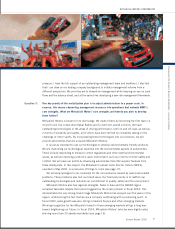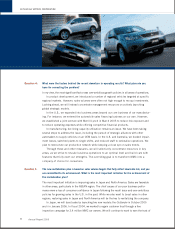Mitsubishi 2005 Annual Report Download - page 19
Download and view the complete annual report
Please find page 19 of the 2005 Mitsubishi annual report below. You can navigate through the pages in the report by either clicking on the pages listed below, or by using the keyword search tool below to find specific information within the annual report.
17
MITSUBISHI MOTORS CORPORATION
Annual Report 2005
In May 2005, MMC announced the MIEV concept, which
collectively refers to the test vehicles and technologies
associated with a program to develop proprietary electric
vehicle technology.
MIEV incorporates two core technologies: the in-wheel
motor, which makes the drivetrain more compact; and a
lithium-ion battery, which boasts outstanding energy density
and other properties. Development is under way with the
aim of commercializing the first MIEV in the next several
years. At the same time, MMC aims to create technologies
that can be applied in hybrid and fuel cell vehicles.
<MIEV Features>
1. In-wheel Motors
In-wheel motors represent an innovative technology that powers
vehicles using only high-performance, compact motors that
fit inside the wheels, eliminating the need for transmis-
sions, driveshafts and other complicated drive systems.
The
Colt EV
, the first MIEV test car, has two in-wheel
motors installed in its rear wheels. The
Lancer Evolution
MIEV
, the second test car, is equipped with new-type in-wheel
motors, which deliver even more power, in all four wheels.
(I) Free Layouts
Putting the drivetrain system in a compact form inside the
wheels makes a dramatic difference in terms of freeing up
the layout of the vehicle. This further increases the
potential of electric vehicles, including the possibility to
improve passive safety and driving performance, enabling
the creation of innovative exterior designs and creating
spacious cabin environments. At the same time, this also
makes the in-wheel motor a promising technology for use
in hybrid vehicles, as well as in fuel cell vehicles where
considerable space is needed to accommodate the fuel
cell stack and hydrogen tanks.
(II) Progress in All-wheel Control Technology
Installing in-wheel motors in all four wheels realizes
advanced control of driving and braking force indepen-
dently for each wheel, contributing to high levels of driving
performance. These components therefore offer the
possibility of wider application and enhancement of the
company’s all-wheel control technology currently used in
the
Lancer Evolution
,
Pajero
and other models.
Schematic of
Colt EV
, the first MIEV test car. Two in-wheel motors are
installed in the rear wheels. Driving tests are currently being conducted to
identify and surmount the technical issues posed by in-wheel motors.
MIEV (Mitsubishi In-wheel motor Electric Vehicle)
Business Strategies
Electric vehicle technologies centered on in-wheel motors and lithium-
ion batteries can also be applied to hybrid and fuel cell vehicles.
Electric vehicle
MIEV
Hybrid vehicle
Fuel cell vehicle
Inverter
Engine/generator
In-wheel motors
Lithium-ion batteries
Fuel cell
Fuel tank (gasoline)
Fuel tank (hydrogen)
Inverter
Lithium-ion battery In-wheel motor (providing drive)
2. Lithium-ion Batteries
Lithium-ion batteries offer better energy density and life
expectancy than conventional lead-acid or Ni-MH batteries.
MMC has been developing EVs using this type of battery for
many years, including the
Mitsubishi HEV
(1996), the
FTO-
FV
(1998) and the
Eclipse EV
(2000). Public road trials
and other testing have demonstrated the practicality of
such batteries as an EV power source. One of the major
obstacles to the uptake of EVs in the past has been their
limited range. However, with the operating range on a
single charge now up to 150km, there are high hopes for
the commercialization of these vehicles in the years ahead.
The economics of electric vehicles are also compelling, with
electricity for a single recharge costing roughly 75% less
than gasoline during the day and 90% less at night.
























